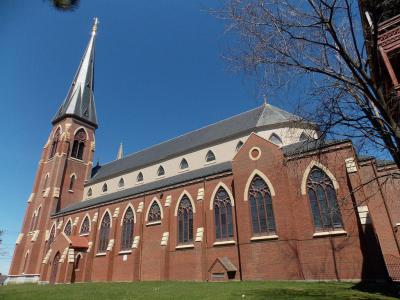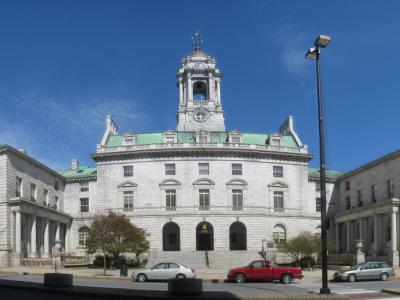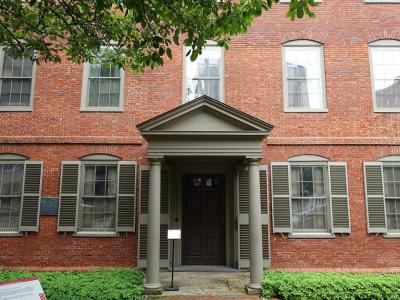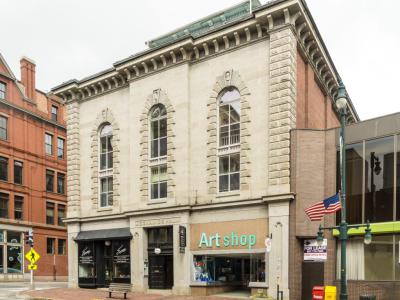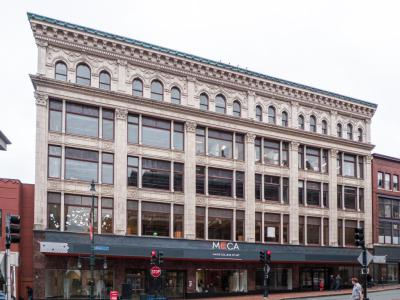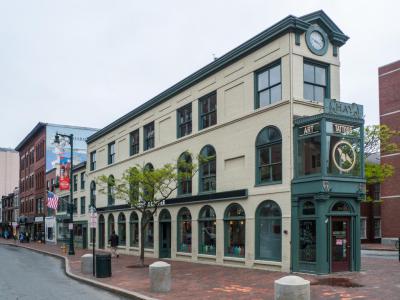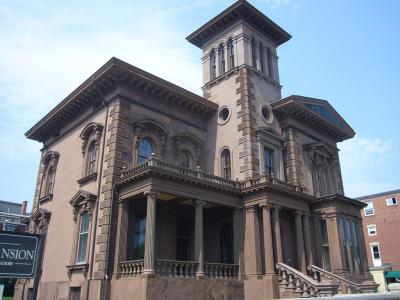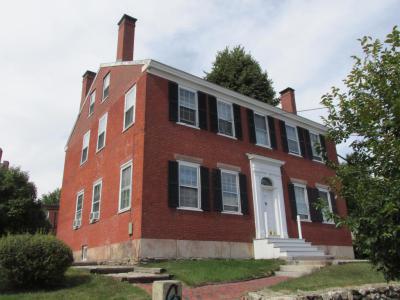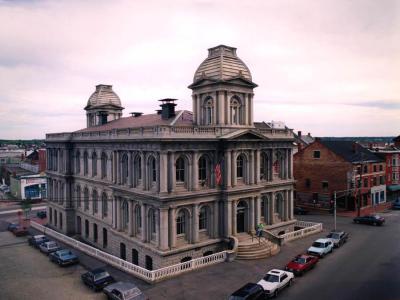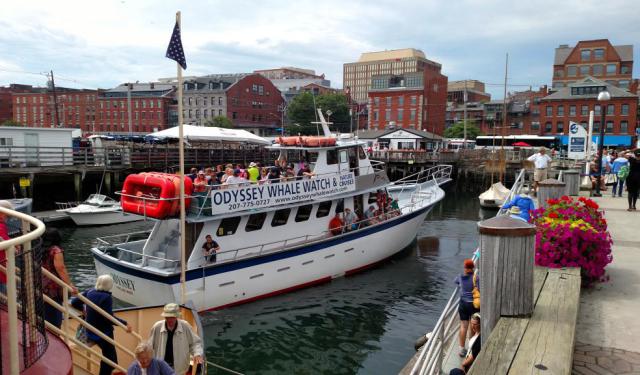Historical Buildings Walking Tour (Self Guided), Portland
Portland, Maine may be small, but it packs centuries of history into its streets. Think of it as a living scrapbook-some pages sing in stone, others whisper in brick, and all of them survived the city’s Great Fire of 1866, which could’ve erased it all. Instead, Portland rebuilt in style, and today you can wander its historic core spotting everything from colonial leftovers to Victorian showpieces and early 20th-century swagger.
The skyline is still claimed by the Cathedral of the Immaculate Conception, a Gothic Revival beauty from the late 1800s with a spire so sharp it looks like it could pierce the clouds. Down by the waterfront, the United States Custom House brings its own gravity: granite, copper, and a fortress-like confidence built to guard the city’s booming harbor. For a quieter chapter, the Wadsworth-Longfellow House ( built in 1785) offers Federal-style charm and a garden oasis. It’s also where poet Henry Wadsworth Longfellow grew up-because a picturesque city like Portland had to raise a literary icon.
Government business got a glow-up with Portland City Hall, a giant of broad steps and bold flourishes, while Victorian taste reached its most dramatic heights in the Victoria Mansion (completed between 1858 and 1860). Also called the Morse-Libby House, this Italianate villa is so lavish it feels like the set of a period drama waiting for actors to arrive.
The early 1900s brought civic pride in stone: the Masonic Temple, with its granite frame and grand halls, and the Porteous, Mitchell & Braun Building, once a department store, now a creative hub in the Arts District. Mechanics’ Hall ( finished in 1859) reminds visitors that artisans helped shape the city as much as merchants, and the Charles Q. Clapp Block shows how sturdy 1820s brick could double as both shopfront and style statement. For domestic history, the Daniel How House (erected in 1817) reveals how everyday Portlanders lived before the city grew into itself.
Taken together, these landmarks read like a timeline etched in stone, brick, and a little marble flair. Stroll through downtown, step inside when you can and you’ll walk away knowing its past without ever cracking a history book
The skyline is still claimed by the Cathedral of the Immaculate Conception, a Gothic Revival beauty from the late 1800s with a spire so sharp it looks like it could pierce the clouds. Down by the waterfront, the United States Custom House brings its own gravity: granite, copper, and a fortress-like confidence built to guard the city’s booming harbor. For a quieter chapter, the Wadsworth-Longfellow House ( built in 1785) offers Federal-style charm and a garden oasis. It’s also where poet Henry Wadsworth Longfellow grew up-because a picturesque city like Portland had to raise a literary icon.
Government business got a glow-up with Portland City Hall, a giant of broad steps and bold flourishes, while Victorian taste reached its most dramatic heights in the Victoria Mansion (completed between 1858 and 1860). Also called the Morse-Libby House, this Italianate villa is so lavish it feels like the set of a period drama waiting for actors to arrive.
The early 1900s brought civic pride in stone: the Masonic Temple, with its granite frame and grand halls, and the Porteous, Mitchell & Braun Building, once a department store, now a creative hub in the Arts District. Mechanics’ Hall ( finished in 1859) reminds visitors that artisans helped shape the city as much as merchants, and the Charles Q. Clapp Block shows how sturdy 1820s brick could double as both shopfront and style statement. For domestic history, the Daniel How House (erected in 1817) reveals how everyday Portlanders lived before the city grew into itself.
Taken together, these landmarks read like a timeline etched in stone, brick, and a little marble flair. Stroll through downtown, step inside when you can and you’ll walk away knowing its past without ever cracking a history book
How it works: Download the app "GPSmyCity: Walks in 1K+ Cities" from Apple App Store or Google Play Store to your mobile phone or tablet. The app turns your mobile device into a personal tour guide and its built-in GPS navigation functions guide you from one tour stop to next. The app works offline, so no data plan is needed when traveling abroad.
Historical Buildings Walking Tour Map
Guide Name: Historical Buildings Walking Tour
Guide Location: USA » Portland (See other walking tours in Portland)
Guide Type: Self-guided Walking Tour (Sightseeing)
# of Attractions: 10
Tour Duration: 2 Hour(s)
Travel Distance: 3.1 Km or 1.9 Miles
Author: DanaOffice
Sight(s) Featured in This Guide:
Guide Location: USA » Portland (See other walking tours in Portland)
Guide Type: Self-guided Walking Tour (Sightseeing)
# of Attractions: 10
Tour Duration: 2 Hour(s)
Travel Distance: 3.1 Km or 1.9 Miles
Author: DanaOffice
Sight(s) Featured in This Guide:
- Cathedral of the Immaculate Conception
- Portland City Hall
- Masonic Temple
- Wadsworth-Longfellow House
- Mechanics' Hall
- Porteous, Mitchell and Braun Company Building
- Charles Q. Clapp Block
- Victoria Mansion
- Daniel How House
- United States Custom House
1) Cathedral of the Immaculate Conception
Portland usually does subtle, however the city outdid itslef courtesy to the Cathedral of the Immaculate Conception. Rising up between Congress and Cumberland Streets, this Gothic Revival giant has been the spiritual and architectural heavyweight of the city since it opened its doors in 1869-just three years after Portland’s Great Fire. Built in red brick trimmed with sandstone and capped with slate, it’s less “quaint parish church” and more “statement piece you can see from half the city.”
The complex isn’t just the cathedral itself. An entire block is taken up by the church, a parish hall, the bishop’s residence, and even a school. From the outside, the show starts with a sandstone Gothic arch framing the main doors, topped by a rose window that throws splashes of color into the nave. To the right, a tower stiffens its shoulders with buttresses and narrow Gothic windows before shooting into the sky with an octagonal spire enough to keep the gulls on notice.
Step inside and the scale hits you. Nearly a thousand worshippers can fit under its soaring vaults, which means it’s a place to feel small in the best way possible. Stained glass, pointed arches, and a sense of vertical drama keep your eyes traveling upward, as if the building itself points to the direction of heaven.
And then there are the spires. Three of them crown the cathedral, but the star is the tallest, climbing 204 feet into the Portland skyline. For decades, it was the city’s highest point, and even now it still lords over the rooftops with quiet confidence.
By 1985, the cathedral’s cultural weight was officially recognized with a spot on the National Register of Historic Places. Today, whether you come for worship, history, or just to crane your neck at Portland’s sharpest steeple, the Cathedral of the Immaculate Conception delivers a masterclass in grandeur.
The complex isn’t just the cathedral itself. An entire block is taken up by the church, a parish hall, the bishop’s residence, and even a school. From the outside, the show starts with a sandstone Gothic arch framing the main doors, topped by a rose window that throws splashes of color into the nave. To the right, a tower stiffens its shoulders with buttresses and narrow Gothic windows before shooting into the sky with an octagonal spire enough to keep the gulls on notice.
Step inside and the scale hits you. Nearly a thousand worshippers can fit under its soaring vaults, which means it’s a place to feel small in the best way possible. Stained glass, pointed arches, and a sense of vertical drama keep your eyes traveling upward, as if the building itself points to the direction of heaven.
And then there are the spires. Three of them crown the cathedral, but the star is the tallest, climbing 204 feet into the Portland skyline. For decades, it was the city’s highest point, and even now it still lords over the rooftops with quiet confidence.
By 1985, the cathedral’s cultural weight was officially recognized with a spot on the National Register of Historic Places. Today, whether you come for worship, history, or just to crane your neck at Portland’s sharpest steeple, the Cathedral of the Immaculate Conception delivers a masterclass in grandeur.
2) Portland City Hall
Portland City Hall has a flair for survival-and for making an entrance. The one standing today, built between 1909 and 1912, is actually the third attempt on this very site. The first was lost in the Great Fire of 1866, the second went up in flames in 1908, and by round three the city decided to bring in the architectural heavyweights Carrère & Hastings to make sure this one stuck. Spoiler: it did.
The result is a Beaux-Arts beauty that could pass for New York City Hall’s cousin. Three stories of stone topped with dormers and a balustrade set the tone, while a 200-foot central tower makes sure you know who’s in charge. The ground floor’s rounded windows soften the edges, but those sweeping staircases up to the entrances give it plenty of drama. Above the central door, the city seal quietly reminds you where you are, in case you somehow forgot.
Step inside and you’ll find the gears of city government grinding away-but City Hall isn’t all business. Swing over to the annex on Myrtle Street and you hit Merrill Auditorium, Portland’s crown jewel of performance spaces. With nearly 2,000 seats and the mighty Kotzschmar Memorial Organ-a 1912 giant that once ranked as the second-largest organ in the world-it’s where politics and pipes both pack a punch.
What’s especially striking is how City Hall ties together history and resilience. It’s not just an office building-it’s a survivor that rose from ashes, twice. That persistence earned it a place on the National Register of Historic Places in 1973.
After surviving two devastating fires, it now stands as a stone-and-steel statement piece at the eastern edge of downtown: part working office, part cultural anchor, and all Portland.
The result is a Beaux-Arts beauty that could pass for New York City Hall’s cousin. Three stories of stone topped with dormers and a balustrade set the tone, while a 200-foot central tower makes sure you know who’s in charge. The ground floor’s rounded windows soften the edges, but those sweeping staircases up to the entrances give it plenty of drama. Above the central door, the city seal quietly reminds you where you are, in case you somehow forgot.
Step inside and you’ll find the gears of city government grinding away-but City Hall isn’t all business. Swing over to the annex on Myrtle Street and you hit Merrill Auditorium, Portland’s crown jewel of performance spaces. With nearly 2,000 seats and the mighty Kotzschmar Memorial Organ-a 1912 giant that once ranked as the second-largest organ in the world-it’s where politics and pipes both pack a punch.
What’s especially striking is how City Hall ties together history and resilience. It’s not just an office building-it’s a survivor that rose from ashes, twice. That persistence earned it a place on the National Register of Historic Places in 1973.
After surviving two devastating fires, it now stands as a stone-and-steel statement piece at the eastern edge of downtown: part working office, part cultural anchor, and all Portland.
3) Masonic Temple
Finished in 1911, the Masonic Temple mixes brick and stone into a façade that means business. The entrance alone sets the tone: two stories high, framed by broad pilasters, with a big round-arched window above that feels like it’s watching who comes and goes. Add in Corinthian columns, recessed bays, and a frieze that slices across the front like a fancy belt buckle, and you’ve got one of Portland’s most commanding downtown landmarks.
Inside is where things get truly theatrical. The Masonic Temple’s halls and meeting rooms are some of the most elaborate interiors in Maine-spaces where carved wood, ornate stone, and grand staircases combine to impress. It’s no wonder it landed on the National Register of Historic Places in 1982; the place practically begs for recognition.
But the story goes deeper than just good looks. The Grand Lodge of Maine, founded in 1820, runs the show here. Its lineage stretches back even further-one of Maine’s earliest Masonic charters was signed by none other than Paul Revere in 1762. For nearly two centuries, this building has been the nerve center of Masonic life in the state.
By 2008, though, the upkeep was getting pricey, and the Masons put the building up for sale. The Temple still thrives today by renting out its grand rooms for weddings, galas, and events-because if you’ve got some of the most impressive interiors in Maine, why not share them?
The Masonic Temple may guard its mysteries well, but it’s not above letting you in-especially if there’s music, champagne, or a packed dance floor involved. Some legacies stay standing; this one stays busy.
Inside is where things get truly theatrical. The Masonic Temple’s halls and meeting rooms are some of the most elaborate interiors in Maine-spaces where carved wood, ornate stone, and grand staircases combine to impress. It’s no wonder it landed on the National Register of Historic Places in 1982; the place practically begs for recognition.
But the story goes deeper than just good looks. The Grand Lodge of Maine, founded in 1820, runs the show here. Its lineage stretches back even further-one of Maine’s earliest Masonic charters was signed by none other than Paul Revere in 1762. For nearly two centuries, this building has been the nerve center of Masonic life in the state.
By 2008, though, the upkeep was getting pricey, and the Masons put the building up for sale. The Temple still thrives today by renting out its grand rooms for weddings, galas, and events-because if you’ve got some of the most impressive interiors in Maine, why not share them?
The Masonic Temple may guard its mysteries well, but it’s not above letting you in-especially if there’s music, champagne, or a packed dance floor involved. Some legacies stay standing; this one stays busy.
4) Wadsworth-Longfellow House
The Wadsworth–Longfellow House blends history, poetry, and over two centuries of Portland life in one address. Built between 1785 and 1786 by General Peleg Wadsworth-a Revolutionary War veteran with ten children to house-it was the city’s first all-brick residence and, remarkably, is still the oldest building standing on the peninsula. If Portland has a staying-power trophy, this place could claim it.
Originally a sturdy two-story home, it gained a third floor in the early 1800s with a Federal-style update. It also gained a future literary giant: Henry Wadsworth Longfellow. The poet moved in as an infant and spent the first 35 years of his life here, surrounded by the hum of early Portland life-a cast of family members, the warmth of fireplaces, and the kind of quiet corners any writer would remember.
After Longfellow’s time, his sister Anne Longfellow Pierce became the home’s last family resident. She guarded its Revolutionary-era spirit with care, right down to the furnishings. When she died in 1901, she left the property to the Maine Historical Society, ensuring its preservation for generations.
Today, walking through its rooms feels like leafing through chapters of American history and literary heritage at the same time. Original family belongings remain in place, the interiors reflect the era’s character, and the walls still seem to carry the energy of a young Henry at work. It’s more than an architectural relic-it’s a chance to step directly into the world that shaped one of America’s best-loved poets.
Originally a sturdy two-story home, it gained a third floor in the early 1800s with a Federal-style update. It also gained a future literary giant: Henry Wadsworth Longfellow. The poet moved in as an infant and spent the first 35 years of his life here, surrounded by the hum of early Portland life-a cast of family members, the warmth of fireplaces, and the kind of quiet corners any writer would remember.
After Longfellow’s time, his sister Anne Longfellow Pierce became the home’s last family resident. She guarded its Revolutionary-era spirit with care, right down to the furnishings. When she died in 1901, she left the property to the Maine Historical Society, ensuring its preservation for generations.
Today, walking through its rooms feels like leafing through chapters of American history and literary heritage at the same time. Original family belongings remain in place, the interiors reflect the era’s character, and the walls still seem to carry the energy of a young Henry at work. It’s more than an architectural relic-it’s a chance to step directly into the world that shaped one of America’s best-loved poets.
5) Mechanics' Hall
Mechanics’ Hall has been Portland’s headquarters for makers, builders, and big ideas since the late 1850s. The Maine Charitable Mechanic Association put it up between 1857 and 1859, giving local artisans a place to gather, share skills, and swap knowledge long before “networking” was a buzzword.
The building’s proportions play a clever trick: a soaring second floor makes it look like it’s three stories tall. Out front, a granite façade delivers the formality, while the brick sides do the hard work of standing up to Maine winters. At the entrance, carved stone posts and a lintel engraved with its name offer a kind of 19th-century branding-built to be read for generations.
Tall, rounded windows keep the place bright, and a decorative trim along the roofline gives it a bit of polish. Inside, the ground floor opens into a broad hall that once hosted everything from public lectures to community celebrations. The original plans even set aside space for a library, because a true mechanics’ guild needed as much knowledge as it did tools. The upper floor, originally one vast meeting room, was later divided into two levels to keep pace with the city’s changing needs.
More than 160 years on, Mechanics’ Hall still draws a crowd-though now it’s just as likely for a poetry reading or concert as it is for a tradesman’s meeting. Added to the National Register of Historic Places in 1973, it remains a reminder that buildings made for the community tend to last, especially when they’re built with both purpose and pride.
The building’s proportions play a clever trick: a soaring second floor makes it look like it’s three stories tall. Out front, a granite façade delivers the formality, while the brick sides do the hard work of standing up to Maine winters. At the entrance, carved stone posts and a lintel engraved with its name offer a kind of 19th-century branding-built to be read for generations.
Tall, rounded windows keep the place bright, and a decorative trim along the roofline gives it a bit of polish. Inside, the ground floor opens into a broad hall that once hosted everything from public lectures to community celebrations. The original plans even set aside space for a library, because a true mechanics’ guild needed as much knowledge as it did tools. The upper floor, originally one vast meeting room, was later divided into two levels to keep pace with the city’s changing needs.
More than 160 years on, Mechanics’ Hall still draws a crowd-though now it’s just as likely for a poetry reading or concert as it is for a tradesman’s meeting. Added to the National Register of Historic Places in 1973, it remains a reminder that buildings made for the community tend to last, especially when they’re built with both purpose and pride.
6) Porteous, Mitchell and Braun Company Building
The Miller Building-better remembered by locals as the Porteous, Mitchell, and Braun Company Building-was once Portland’s temple of retail therapy, back when department stores were social events as much as shopping trips. Today it anchors the Arts District with a new purpose, housing the Maine College of Art, but its grand exterior still hints at the days of shopping bags, window displays, and Saturday crowds.
Built in 1904, it got a major glow-up in 1911 when George Burnham expanded it for the Porteous company. By 1953, it stretched all the way to Free Street, making it the city’s biggest department store. For decades, this was where you’d find everything from hats to homewares-until the store closed in 1991. Instead of the wrecking ball, the building got a second chance, restored and added to the National Register of Historic Places in 1996.
From the sidewalk, it’s hard to miss. Brick walls are trimmed with light-colored terra cotta, while big display windows line the ground floor. Above, tall vertical strips separate the upper windows, giving the building a sense of height and rhythm. The top floor changes it up with rounded windows and a decorative edge along the roofline-just enough flourish to catch your eye without going over the top.
These days, instead of cash registers and perfume counters, you’ll find easels, studios, and classrooms buzzing with creativity. The Miller Building has gone from Portland’s shopping hub to its creative heartbeat-a place that proves some addresses don’t fade from the spotlight, they just change their role.
Built in 1904, it got a major glow-up in 1911 when George Burnham expanded it for the Porteous company. By 1953, it stretched all the way to Free Street, making it the city’s biggest department store. For decades, this was where you’d find everything from hats to homewares-until the store closed in 1991. Instead of the wrecking ball, the building got a second chance, restored and added to the National Register of Historic Places in 1996.
From the sidewalk, it’s hard to miss. Brick walls are trimmed with light-colored terra cotta, while big display windows line the ground floor. Above, tall vertical strips separate the upper windows, giving the building a sense of height and rhythm. The top floor changes it up with rounded windows and a decorative edge along the roofline-just enough flourish to catch your eye without going over the top.
These days, instead of cash registers and perfume counters, you’ll find easels, studios, and classrooms buzzing with creativity. The Miller Building has gone from Portland’s shopping hub to its creative heartbeat-a place that proves some addresses don’t fade from the spotlight, they just change their role.
7) Charles Q. Clapp Block
The Hay Building-better known to locals as the Charles Q. Clapp Building-is one of downtown Portland’s proud survivors. Built in 1826 by Charles Q. Clapp himself, it’s one of the city’s oldest commercial blocks, still holding its corner at the busy crossroads of Congress, High, and Free Streets. If buildings could talk, this one would probably remind its younger neighbors it was in business long before Portland even had streetcars.
The main section is three stories of pale brick with green trim, its first two floors framed by arched windows that give it a friendly, almost winking look. The third floor was added in 1922, topped with a tidy cornice that ties it all together. Sharing the block are two smaller companions-one a shorter three-story with square windows and a storefront, the other a 2½-story building with a recessed doorway and a decorative railing that’s more about looks than protection.
Originally a clean-lined Federal-style design, the building earned its lasting nickname thanks to Hay’s Pharmacy, which set up shop on the ground floor in 1841. The name stuck, even as the upper floors changed and the tenants came and went.
Now on the National Register of Historic Places, the Hay Building stands like a three-piece time capsule-part history lesson, part downtown anchor, and part reminder that Portland has been blending business and personality for nearly 200 years.
The main section is three stories of pale brick with green trim, its first two floors framed by arched windows that give it a friendly, almost winking look. The third floor was added in 1922, topped with a tidy cornice that ties it all together. Sharing the block are two smaller companions-one a shorter three-story with square windows and a storefront, the other a 2½-story building with a recessed doorway and a decorative railing that’s more about looks than protection.
Originally a clean-lined Federal-style design, the building earned its lasting nickname thanks to Hay’s Pharmacy, which set up shop on the ground floor in 1841. The name stuck, even as the upper floors changed and the tenants came and went.
Now on the National Register of Historic Places, the Hay Building stands like a three-piece time capsule-part history lesson, part downtown anchor, and part reminder that Portland has been blending business and personality for nearly 200 years.
8) Victoria Mansion (must see)
Victoria Mansion is the city’s very own architectural gem-a dazzling example of American residential design from the mid-19th century. Built in 1860 as a summer escape for Ruggles Sylvester Morse, a hotel magnate who struck it rich in New York, Boston, and New Orleans, this mansion oozes grandeur and history.
Designed by Henry Austin, this brownstone Italianate beauty got that cool, asymmetrical flair with a four-story tower, overhanging eaves, and verandas that practically beg you to relax with a cool drink. Inside, the mansion’s charm continues with intricate frescoes and three-dimensional wall art, all thanks to the talented Giuseppe Guidicini.
The mansion had a cozy family feel until 1928, when the last member of the Libby family left. After the economic hardships of the Great Depression and the disastrous 1938 Portland flood, the house faced potential demolition (seriously, a gas station was on the cards). But, thankfully, the mansion was rescued in 1941, and lovingly restored to honor its royal inspiration-Queen Victoria.
Now listed on the National Historic Register, Victoria Mansion is a museum that transports you straight back to the opulent 19th century. It's a true testament to Portland’s rich history and an absolute must-see for anyone who enjoys a bit of grandeur, with a side of history-and maybe royalty sprinkled in.
Designed by Henry Austin, this brownstone Italianate beauty got that cool, asymmetrical flair with a four-story tower, overhanging eaves, and verandas that practically beg you to relax with a cool drink. Inside, the mansion’s charm continues with intricate frescoes and three-dimensional wall art, all thanks to the talented Giuseppe Guidicini.
The mansion had a cozy family feel until 1928, when the last member of the Libby family left. After the economic hardships of the Great Depression and the disastrous 1938 Portland flood, the house faced potential demolition (seriously, a gas station was on the cards). But, thankfully, the mansion was rescued in 1941, and lovingly restored to honor its royal inspiration-Queen Victoria.
Now listed on the National Historic Register, Victoria Mansion is a museum that transports you straight back to the opulent 19th century. It's a true testament to Portland’s rich history and an absolute must-see for anyone who enjoys a bit of grandeur, with a side of history-and maybe royalty sprinkled in.
9) Daniel How House
The Daniel How House doesn’t just sit on Danforth Street-it all but nods, “I was here first.” Built in 1799, it’s one of the oldest surviving homes in Portland, a brick veteran that even outlasted the city’s great fire of 1866. It also happens to be one of the best-preserved examples of Federal-period architecture in town, which is why it snagged a spot on the National Register of Historic Places in 1973.
This 2½-story home was crafted from locally made brick, with brownstone lintels and perfectly balanced windows that give it a quiet, no-nonsense elegance. The front doorway has been faithfully recreated to match its original design, while inside, the woodwork and floors are as authentic as they come. At the center, a graceful staircase spirals upward drawing your eyes along with it.
In its early days, the Daniel How House enjoyed unbroken views of the waterfront and Casco Bay-long before Commercial Street came in. Just behind it on Pleasant Street, two other How family homes popped up, forming a tidy little clan of brick survivors that still stands today.
Restored in the 1970s, the Daniel How House keeps its history close and its style intact. While the rest of Portland has been busy reinventing itself, this place has been quietly proving that some legacies don’t need a facelift-they just need a good foundation.
This 2½-story home was crafted from locally made brick, with brownstone lintels and perfectly balanced windows that give it a quiet, no-nonsense elegance. The front doorway has been faithfully recreated to match its original design, while inside, the woodwork and floors are as authentic as they come. At the center, a graceful staircase spirals upward drawing your eyes along with it.
In its early days, the Daniel How House enjoyed unbroken views of the waterfront and Casco Bay-long before Commercial Street came in. Just behind it on Pleasant Street, two other How family homes popped up, forming a tidy little clan of brick survivors that still stands today.
Restored in the 1970s, the Daniel How House keeps its history close and its style intact. While the rest of Portland has been busy reinventing itself, this place has been quietly proving that some legacies don’t need a facelift-they just need a good foundation.
10) United States Custom House
The United States Custom House is basically Portland’s granite love letter to maritime trade. Built between 1867 and 1872, it rose from the ashes of the Great Fire with one clear mission: keep the booming harbor in check and the customs business running like clockwork.
Crafted from rugged New Hampshire granite and topped with a slate roof tough enough to laugh at sparks, the Custom House was fireproof by design-a cautious nod to the inferno of 1866. Its I-shaped layout and three sturdy stories give it the kind of presence that says, “business first, beauty second”-though it manages to pull off both with ease.
The style is part Renaissance Revival, part Second Empire, and all confidence. Two square towers capped with slightly sloping roofs crown the building like a pair of granite crowns, flanked by Corinthian pilasters that add a touch of theatrical drama. Venetian-style arched windows soften the heavy granite walls, each topped by its own shallow pediment, like architectural eyebrows raised just high enough to impress.
But the Custom House is more than an elegant façade-it’s a symbol. This was the gatekeeper of Portland’s economy, where the Atlantic world funneled into ledgers, tariffs, and fortunes. Today, listed on the National Register of Historic Places, it’s still one of the city’s sharpest dressers. Granite, symmetry, and just enough French swagger-it’s ready to collect tariffs, throw a party, or simply remind you that Portland’s pride was once measured in tall ship masts.
Crafted from rugged New Hampshire granite and topped with a slate roof tough enough to laugh at sparks, the Custom House was fireproof by design-a cautious nod to the inferno of 1866. Its I-shaped layout and three sturdy stories give it the kind of presence that says, “business first, beauty second”-though it manages to pull off both with ease.
The style is part Renaissance Revival, part Second Empire, and all confidence. Two square towers capped with slightly sloping roofs crown the building like a pair of granite crowns, flanked by Corinthian pilasters that add a touch of theatrical drama. Venetian-style arched windows soften the heavy granite walls, each topped by its own shallow pediment, like architectural eyebrows raised just high enough to impress.
But the Custom House is more than an elegant façade-it’s a symbol. This was the gatekeeper of Portland’s economy, where the Atlantic world funneled into ledgers, tariffs, and fortunes. Today, listed on the National Register of Historic Places, it’s still one of the city’s sharpest dressers. Granite, symmetry, and just enough French swagger-it’s ready to collect tariffs, throw a party, or simply remind you that Portland’s pride was once measured in tall ship masts.
Walking Tours in Portland, Maine
Create Your Own Walk in Portland
Creating your own self-guided walk in Portland is easy and fun. Choose the city attractions that you want to see and a walk route map will be created just for you. You can even set your hotel as the start point of the walk.
Portland Maine Introduction Walking Tour
If New York is the city that never sleeps, Portland, Maine, is the city that daydreams with an ocean breeze. Jutting out into Casco Bay, this coastal gem balances big-city energy with the easygoing warmth of a neighborhood you’ve known your whole life.
Long before lobster shacks and artisan coffee shops, the Algonquian people (populous indigenous American group) called this land... view more
Tour Duration: 2 Hour(s)
Travel Distance: 2.5 Km or 1.6 Miles
Long before lobster shacks and artisan coffee shops, the Algonquian people (populous indigenous American group) called this land... view more
Tour Duration: 2 Hour(s)
Travel Distance: 2.5 Km or 1.6 Miles
The Most Popular Cities
/ view all



